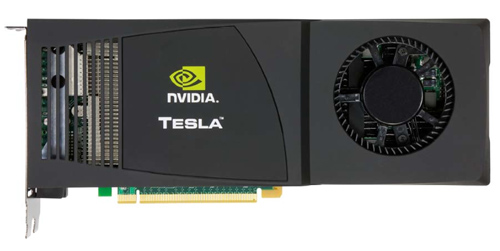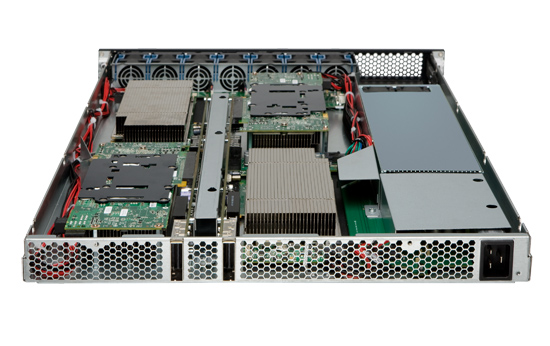NVIDIA's Fermi: Architected for Tesla, 3 Billion Transistors in 2010
by Anand Lal Shimpi on September 30, 2009 12:00 AM EST- Posted in
- GPUs
A Different Sort of Launch
Fermi will support DirectX 11 and NVIDIA believes it'll be faster than the Radeon HD 5870 in 3D games. With 3 billion transistors, it had better be. But that's the extent of what NVIDIA is willing to talk about with regards to Fermi as a gaming GPU. Sorry folks, today's launch is targeted entirely at Tesla.

A GeForce GTX 280 with 4GB of memory is the foundation for the Tesla C1060 cards
Tesla is NVIDIA's High Performance Computing (HPC) business. NVIDIA takes its consumer GPUs, equips them with a ton of memory, and sells them in personal or datacenter supercomputers called Tesla supercomputers or computing clusters. If you have an application that can run well on a GPU, the upside is tremendous.

Four of those C1060 cards in a 1U chassis make the Tesla S1070. PCIe connects the S1070 to the host server.
NVIDIA loves to cite examples of where algorithms ported to GPUs work so much better than CPUs. One such example is a seismic processing application that HESS found ran very well on NVIDIA GPUs. It migrated a cluster of 2000 servers to 32 Tesla S1070s, bringing total costs down from $8M to $400K, and total power from 1200kW down to 45kW.
| HESS Seismic Processing Example | Tesla | CPU |
| Performance | 1 | 1 |
| # of Machines | 32 Tesla S1070s | 2000 x86 servers |
| Total Cost | ~$400K | ~$8M |
| Total Power | 45kW | 1200kW |
Obviously this doesn't include the servers needed to drive the Teslas, but presumably that's not a significant cost. Either way the potential is there, it's just a matter of how many similar applications exist in the world.
According to NVIDIA, there are many more cases like this in the market. The table below shows what NVIDIA believes is the total available market in the next 18 months for these various HPC segments:
| Processor | Seismic | Supercomputing | Universities | Defence | Finance |
| GPU TAM | $300M | $200M | $150M | $250M | $230M |
These figures were calculated by looking at the algorithms used in each segment, the number of Hess-like Tesla installations that can be done, and the current budget for non-GPU based computing in those markets. If NVIDIA met its goals here, the Tesla business could be bigger than the GeForce one. There's just one problem:
As you'll soon see, many of the architectural features of Fermi are targeted specifically for Tesla markets. The same could be said about GT200, albeit to a lesser degree. Yet Tesla accounted for less than 1.3% of NVIDIA's total revenue last quarter.
Given these numbers it looks like NVIDIA is building GPUs for a world that doesn't exist. NVIDIA doesn't agree.
The Evolution of GPU Computing
When matched with the right algorithms and programming efforts, GPU computing can provide some real speedups. Much of Fermi's architecture is designed to improve performance in these HPC and other GPU compute applications.
Ever since G80, NVIDIA has been on this path to bring GPU computing to reality. I rarely get the opportunity to get a non-marketing answer out of NVIDIA, but in talking to Jonah Alben (VP of GPU Engineering) I had an unusually frank discussion.
From the outside, G80 looks to be a GPU architected for compute. Internally, NVIDIA viewed it as an opportunistic way to enable more general purpose computing on its GPUs. The transition to a unified shader architecture gave NVIDIA the chance to, relatively easily, turn G80 into more than just a GPU. NVIDIA viewed GPU computing as a future strength for the company, so G80 led a dual life. Awesome graphics chip by day, the foundation for CUDA by night.
Remember that G80 was hashed out back in 2002 - 2003. NVIDIA had some ideas of where it wanted to take GPU computing, but it wasn't until G80 hit that customers started providing feedback that ultimately shaped the way GT200 and Fermi turned out.
One key example was support for double precision floating point. The feature wasn't added until GT200 and even then, it was only added based on computing customer feedback from G80. Fermi kicks double precision performance up another notch as it now executes FP64 ops at half of its FP32 rate (more on this later).
While G80 and GT200 were still primarily graphics chips, NVIDIA views Fermi as a processor that makes compute just as serious as graphics. NVIDIA believes it's on a different course, at least for the short term, than AMD. And you'll see this in many of the architectural features of Fermi.










415 Comments
View All Comments
hazarama - Saturday, October 3, 2009 - link
"Do you see any sign of commercial software support? Anybody Nvidia can point to and say "they are porting $important_app to openCL"? I haven't heard a mention. That pretty much puts Nvidia's GPU computing schemes solely in the realm of academia"Maybe you should check out Snow Leopard ..
samspqr - Friday, October 2, 2009 - link
Well, I do HPC for a living, and I think it's too early to push GPU computing so hard because I've tried to use it, and gave up because it required too much effort (and I didn't know exactly how much I would gain in my particular applications).I've also tried to promote GPU computing among some peers who are even more hardcore HPC users, and they didn't pick it up either.
If even your typical physicist is scared by the complexity of the tool, it's too early.
(as I'm told, there was a time when similar efforts were needed in order to use the mathematical coprocessor...)
Yojimbo - Sunday, October 4, 2009 - link
>>If even your typical physicist is scared by the complexity of the >>tool, it's too early.This sounds good but it's not accurate. Physicists are interested in physics and most are not too keen on learning some new programing technique unless it is obvious that it will make a big difference for them. Even then, adoption is likely to be slow due to inertia. Nvidia is trying to break that inertia by pushing gpu computing. First they need to put the hardware in place and then they need to convince people to use it and put the software in place. They don't expect it to work like a switch. If they think the tools are in place to make it viable, then how is the time to push, because it will ALWAYS require a lot of effort when making the switch.
jessicafae - Saturday, October 3, 2009 - link
Fantastic article.I do bioinformatics / HPC and in our field too we have had several good GPU ports for a handful for algorithms, but nothing so great to drive us to add massive amounts of GPU racks to our clusters. With OpenCL coming available this year, the programming model is dramatically improved and we will see a lot more research and prototypes of code being ported to OpenCL.
I feel we are still in the research phase of GPU computing for HPC (workstations, a few GPU racks, lots of software development work). I am guessing it will be 2+ years till GPU/stream/OpenCL algorithms warrant wide-spread adoption of GPUs in clusters. I think a telling example is the RIKEN 12petaflop supercomputer which is switching to a complete scalar processor approach (100,000 Sparc64 VIIIfx chips with 800,000 cores)
http://www.fujitsu.com/global/news/pr/archives/mon...">http://www.fujitsu.com/global/news/pr/archives/mon...
Thatguy97 - Thursday, May 28, 2015 - link
oh fermi how i miss ya hot underperforming ass